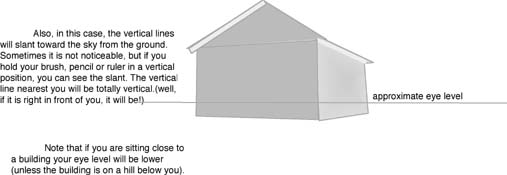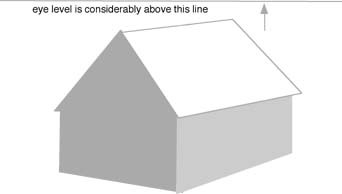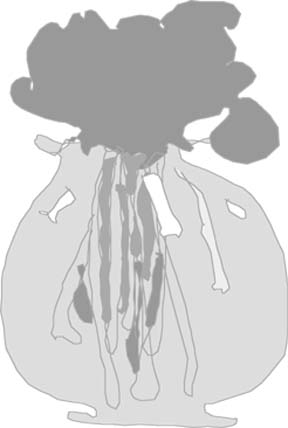Lesson 7
By Mary Ann Boysen
A trip to see Monets Garden in Giverny in Northern France is a delight. My students and I had been painting in ancient villages near the small village of Renazé in western France for a week, then packed our bags and painting supplies and headed to the northern coast to see Mont St. Michel, the American Cemetery at Normandy, Honfleur Harbor and down to Giverny. |
Related topics:
Snowy Landscape
Painting Lace
|
In this lesson we will be covering negative shapes and perspective. Let's begin by examining a simple picket fence. Most picket fences are white. Therefore, as watercolorists, we do not need to paint the fence, but we do need to take a close look at what is behind the fence. There is our subject (called the negative shape because it has the important accent color). There may be a shadow across the white fence, and it may be painted first or last in a very quick and casual manner.
Tedium is not what we want when painting in a journal. These must be quickly done so that we may move on to the next location to record our visions. Notice that the background varies in value and can vary in color depending on what is behind the fence.

I have given the fence a slight value here so that you can see more clearly, but it can remain white (the white of the paper).
For starters: draw a picket fence with a pencil, and shade the background with the pencil.
Next: in the journal beside the drawing, paint only the background color, leaving the pickets white. When this is dry, you may cast a shadow across the fence for variation. To do this, mix a very pale wash of a shadow color with red, yellow and blue, and with great abandon, slop the paint across the fence, leaving white areas for sunlight.
Flowers
There are several ways to approach flowers due to the fact that there are so many shapes involved.
One of the easiest ways is to paint the entire flower shape in a very pale color, so that you have an idea of how much space it will fill on the page. Using a pointed brush (actually the flat brush will do as well), concentrate on the darker colors in the flower, and the shapes that you see. Paint them one by one around the flower until the actual flower comes alive! Of course, you may get as detailed as you wish, but the freshest ones are the loosest ones. Don’t overwork the detail. Keep your colors moist and use lots of water to keep the paint transparent.

These are very simplified shapes, but one must start with “simple” before you understand the concept.

Perspective
Next, we will tackle that age old problem of PERSPECTIVE. Two and three point perspective, taught
In the old fashioned way, is confusing and leads to some very strange looking structures! I prefer to teach it as relative shapes and sizes. There are a few tricks that one can use, but if you really concentrate on shapes (which you should be good at by now!) you will begin to see what I mean.
Perspective: The size and diminishing shapes of buildings are all relative to the objects around them.
- It is important for you to notice the relative sizes and the directions of horizontal lines.
- Vertical lines are always vertical (unless a building is leaning!), but horizontal lines vary intheir degree from one point to another. Perspective: The size and diminishing shapes of buildings are all relative to the objects around them.
Every traditional painting has a horizontal line called “eye level”, which means that as you are sitting or standing, that line is the level of your eyes.
This line is invisible, of course, so you must make yourself look at the landscape for the most level horizontal line, whether it be in a building, a fence, a window, etc. That will determine how the other horizontal lines fall in the painting or drawing. Simple shapes found in the tulip, for example, can be painted individually, one petal at a time.
Flower stems are more challenging. We will address that subject later.
 All horizontal lines beneath eye level will be drawn from the vertical line nearest you in an upward direction toward eye level. Likewise, any lines above eye level will be drawn in a downward direction from the vertical line nearest you. All horizontal lines beneath eye level will be drawn from the vertical line nearest you in an upward direction toward eye level. Likewise, any lines above eye level will be drawn in a downward direction from the vertical line nearest you.
In the illustration above, the vertical line nearest you is the mid object line. As you can see, the horizontal lines at the bottom of the house go toward the “eye level” line on either side of the mid object vertical.
The lower edge of the roof is above the eye level line, so it slants downward from the vertical line closest to you (mid object). The top of the roof has more of a slant as it is further from eye level.
Sometimes, if you are sitting close to a building, you know that it has a roof, but if you really look closely, you cannot see it, hence the illustration on the next page. The roof that you see or don’t see varies with the distance from the object from which you are sitting.

Notice that the underside of the roof line on the left is lighter than the side. Why? It is a more horizontal surface than the vertical side of the building and is receiving “reflected” light from ground or the building. It is best to apply a warm color to that surface to show the reflected light.
If you are above the building on a hill, you will see more of the roof, and the vertical lines will slant the opposite direction.

The central vertcal line is the vertical closest to you so it will be the longest from top to bottom and all lines extending from it will go toward the eye level line.
In this drawing you would not see the underside of the roof overhang, as you are above it.
Now, it is your turn to select a brush and paint the building. What brush would you use for a square surface?
Answer: a flat brush. With one stroke or two, you can make a square shape. It is futile to use any other shape brush, as you must make too many brush strokes to create the square.
It is truly amazing that you can paint a dark around part of a light subject and make the subject appear on your paper. This is one way to do “negative painting”. It makes the positive shape appear.
This is rather a simple procedure that most people fear is difficult. Just stop and think about what you a seeing. Don’t be afraid of the white paper. This painting style does not use the glazing method where we put color all over the paper first to create a mood. There is no drying time for that procedure when you are on vacation and painting in a journal. We just dive right into the subject, simplifying shapes as we proceed.
- Lay in one side of the building

- Then the second side with another value (or leave it white, and paint the background trees to create the back side of the building.
It is truly amazing that you can paint a dark around part of a light subject and make the subject appear on your paper. This is one way to do “negative painting”. It makes the positive shape appear.
This is rather a simple procedure that most people fear is difficult. Just stop and think about what you a seeing. Don’t be afraid of the white paper. This painting style does not use the glazing method where we put color all over the paper first to create a mood. There is no drying time for that procedure when you are on vacation and painting in a journal. We just dive right into the subject, simplifying shapes as we proceed.
Painting flower stems in a vase
Most journal painting deals with landscapes, but occasionally a still life will be involved. This is a relatively simplistic and primitive computer drawing of flowers in a vase. Note the darker shapes between the flower stems. Instead of painting the flower stems, paint the shapes that you see in between them.
If you wish to paint the stems first in a pale color, you can then see the shapes between them, and paint those shapes darker.
As you proceed, you will notice that some stems are in front of others. Here, you can cast a slight shadow over the background stem, or paint the entire stem a slightly darker value to push it into the background.
Highlights may be left in the glass to create the reflective quality. The highlights will conform to the shape of the vase. If it is a vertical vase the highlights will be vertical shapes. If it is more round, the highlights will curve.
You might prefer to paint the house next door, as it is further away and the perspective angles will be more gentle. The surrounding evergreens make the house stand out, so think of that when you begin. Perhaps it would be best to paint the trees first, concentrating on the edges of the house and roofline that stand out against the darks.
If we must paint from photographs, keep the subject simple. Choose one that has a building in it so that you can deal with perspective, lights and shadows, and reflected light.
If you are a beginner, you might just want to concentrate on part of a building, such as the windows, the porch, etc. so that you don’t feel overwhelmed.
As you paint (the more you paint) you will become more comfortable with the brush and realize that this is a much easier project than you previously thought. The completion time is much quicker when we don’t have to concentrate on drawing with a pencil, then filling in the blanks. Why zip, zip, zip when one zip does it? Why draw all four sides of a square when one stroke with a flat brush will paint the square?
Even if you draw your subject first because it is too complicated, you will find yourself not needing to draw ALL the details, but painting them with the brush instead. This is a real eye-opener for observing shapes and being able to create a painting with them.

<<Lesson 6: Paint without Drawing
Lesson 8: Brightening the Winter Landscape
Return to Watercolor Lessons
Watercolor Painting Tips
You can also see the 20 videos of mine on YOUTUBE
Return to Watercolor Techniques
Return to Watercolor Painting Tips Home

|

